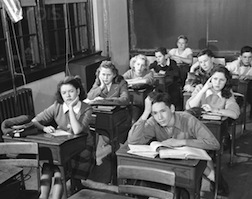How can you tell when people are being entertained? As a scientist, I’m always looking for a relatively objective way of measuring things. So rather than read reviews or listen to opinions, I’d look at the behavior of the audience. When an audience is engaged their eyes are open and focused. They lean forward with an intent look on their face. They respond by nodding, smiling, laughing, even weeping. By my definition, engagement = entertainment.
A bored audience, on the other hand, has a very different appearance. If you peered into a theater and saw people looking vacantly about, or resting their heads on their hands, or sleeping, and you had to guess, you could say that they were a captive audience for a presentation that was supposed to be educational. These behaviors are a common occurrence in lectures. Chances are good that members of a bored audience are required to be present. Their job or their school grade depends on it. If they had a choice, they would not buy a ticket to the event.

Interestingly, whether or not an audience is entertained or bored has very little to do with the content of the presentation. It has everything to do with the preparation of the audience. People are engaged when a presentation is about something they already know, but has a slightly different point of view. That’s why well-crafted humor or satire or even riveting theater can deliver a message. It is also explains why a group of neurosurgeons could be transfixed by a demonstration of a new technique in brain surgery -- a performance that would be of little or no interest to anyone else. People are bored when the content is difficult to grasp, is far removed from their own knowledge base, or is so old hat and repetitive that it has no value as confirmation of what they already know.
The best professional entertainers know how to bridge the communication gap to their audience. We all share knowledge of what it means to be a human being. Empathy with characters and what they must be feeling drives the best writing and performing. Shakespeare knew what he was talking about when he said “all’s the world a stage.” He took on epic themes and made us think about the motivation of the characters who bring these themes to life on the stage. Some might say that great theater can be the ultimate learning experience.
The word “education” means “to lead out.” Make no mistake: Teachers are supposed to be leaders. The best leaders speak the language of the people they want to lead. This serves to establish a connection with their followers. They are as clear with the message as where they are taking their followers while building in motivation for them to follow. They are also clear about what is required by followers to reach their goals. This requires some effort on the part of the followers, perhaps going to vote, or showing up on Sunday morning, or doing homework.

Professional entertainers connect immediately with their audience. One hundred fifty years ago, people had to leave their homes to find professional entertainment. For the past 50 or so years, with television, professional entertainment has been available in most homes with the push of a button. Today’s children know all too well how to sit back and listen without exerting much effort. Do they bring that “entertain me” mentality to the classroom? Perhaps. I think the bar is set higher today than in the past when it comes to a teacher’s performance in the classroom. But the teacher has a few more arrows in his/her quiver than television to captivate and engage children.
• A personal relationship with each student so that the student cares about the teacher’s approval.
• Interactivity -- the students can do something besides listen to the teacher during a class.
• Collaboration with other classmates in projects.
• Arranging circumstances so that students perform before others.
• The ability to select engaging instructional material as a substitute for flat and uninteresting material.
• Giving feedback to students on their performances so that they go up the learning curves.
Our goal as educators is to produce that engaged audience so that the casual observer doesn’t see bored vacant faces and conclude that “it must be educational.”

